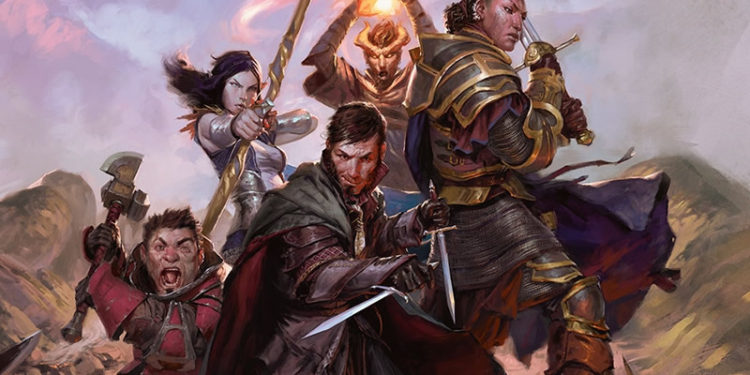Unearthed Arcana 2020: Feats Breakdown

Oh hey, there’s a new UA document, this time with sixteen new feats. Relative to 5e, that’s a lot of feats! It’s been awhile since we last had a collection of feats in UA, and a few of these did appear in another form in that long-long-ago. And that’s probably enough introductory faffing around – let’s get to it.
I should have been doing this all throughout UA breakdowns, but the byline here is Taymoor Rehman, Jeremy Crawford, Ben Petrisor, Dan Dillon, and Ari Levitch.
Artificer Initiate
There are a bunch of pseudo-multiclass feats here, a style of feat that I unreservedly love.
- You gain an artificer cantrip and 1st-level spell. Int is your casting stat, of course. You also get to cast the 1st-level spell once a day without spending a slot, and you can spend slots to cast it normally. I like that the text includes explicit permission to reassign the spells when you gain a level.
- Also you gain proficiency in one artisan’s tool (hurr hurr) and you can make magic with it (hurr2). Sorry, I meant: it’s a spellcasting implement for you.
This feat takes one minor step beyond Magic Initiate – but that’s all we actually need from it to sell its idea, and Magic Initiate doesn’t quite accomplish this on its own. Functional and necessary – this cog is appropriately cog-shaped.
Chef
This is one of the best feat concepts in the whole document, updated from the previous UA Feat offerings, where it was called Gourmand. The previous version did a lot of things; this one is more stripped-down.
- +1 Con or +1 Wis. Interesting options.
- Gain proficiency with cook’s utensils. Better this than making proficiency with them a prerequisite.
- You can cook and serve food during short rests, feeding a whole adventuring party at 1st level and scaling up from there as your proficiency bonus grows. I appreciate that bit in particular, because sometimes high-level parties do have additional NPC teammates and it’s cool that you don’t have to leave them out. Anyway, the food acts like a bard’s Song of Rest feature, granting extra healing when the diners spend at least one Hit Die to heal.
- You can cook a number of Scooby Snacks equal to your proficiency bonus, which have a limited shelf life (8 hours) and grant temporary hit points equal to your proficiency bonus when eaten as a bonus action. I like this as an idea, and the implementation is fine; at most I might like to see one or two alternate effect options, like giving you an extra chance to shake off a condition. (I’m specifically imagining Popeye downing a can of spinach.)
Overall, this feat is very good, and I wouldn’t actually complain if it went into the game in exactly this form. I can still wish for one or two more nuances, especially inspired by the fairly deep cooking minigame of Breath of the Wild. (My wife and I played BotW, and then our 6-year-old decided he absolutely had to play it. Introducing a new generation to Link and Zelda is a beautiful privilege, even if it means I don’t get to play with the Nintendo Switch very often anymore.)
The best way to handle those nuances probably isn’t adding more bullets to this feat, though. Instead, I’d establish that there are more recipes to learn in the world, based on foodstuffs that you purchase, beg, borrow, or slay.
Crusher
This feat, and Piercer and Slasher along with it, are ways to slightly specialize in a weapon type, in an edition where there are very firm guidelines against weapon specialization. They make me antsy just for existing, but I’ll examine them on their own terms.
- +1 Str or +1 Dex. There aren’t a ton of finesse bludgeoning weapons, but there’s one that really matters: a monk’s unarmed strike.
- You get a free 5-ft push once per turn, when you deal bludgeoning damage to a creature. This is some very pure 4e energy; in conjunction with Sentinel’s speed reduction, you can deeply wreck an enemy’s plan for the round with one opportunity attack. I slightly worry that it goes too far, but I’d have to see it in use to be sure.
- Your crits with a bludgeoning weapon cause all attacks against that creature to gain advantage until the end of your next turn. Obviously you can’t generate crits, but this pitches into monks (huge number of attacks) and Champion fighters really, really hard.
- I may not want to play a Champion fighter myself – give me Battle Master eight days a week – but I do like to see feats and such that help them shine.
This is a very powerful feat. Too powerful? The first time a crit against a boss leads to a cascade of crits from the whole party (because… that’s advantage for you), it’s going to feel that way. In many fights, it’ll be a free Shove once a turn, and nothing more. Next to Polearm Master, Great Weapon Master, or Sharpshooter, that’s fine.
Eldritch Adept
This is the warlock multiclass feat that lets you grab an Eldritch Invocation. Or – like Martial Adept – warlocks can buy it to get an extra Eldritch Invocation. The list of no-prereq Eldritch Invocations is short, but it does include Mask of Many Faces, so uh. Yikes. (Oh hey, it’s a feat to be a Faceless Man from Game of Thrones. Do you remember when there was a GoT fandom, and then one week later there just… wasn’t?)
This is probably fine, though it does add another step of consideration to all future Eldritch Invocation design, I guess. They already know about the danger of the Armor of Shadows/Abjurer exploit, so I won’t belabor that point.
Fey Touched
If you’ve read any of my work in Tribality, or my current megathread-in-progress in Twitter, you won’t be amazed that I am all about this feat as a concept.
- +1 Int, Wis, or Cha. Sure, no problem.
- You learn misty step and one 1st-level divination or enchantment spell. (Little surprised illusion isn’t on the list, but okay.) You can cast each of those once without expending a slot, and you can cast them with your spell slots. The casting stat for these is whatever you boosted in the first bullet point.
It’s interesting to see this feat format that expounds upon the theme of Magic Initiate, but here instead of a wildcard cantrip and wildcard 1st-level spell, you get one specific 2nd-level spell and one somewhat-constrained 1st-level spell. It matches up well to the ancestry features that offer cantrip/1st/2nd. Seems fine as written.
Fighting Initiate
Pay a feat, buy a Fighting Style. The only issue I have with it is that a feat for +1 AC (from Defense) feels kind of yucky to me. That’s not really reasonable, though. The good side of this feature, for what I personally care about, is that barbarians, paladins, and rangers don’t need to multiclass to gain a fighting style, or to gain the fighting styles their classes don’t already grant. It’s also worth a look for some clerics, rogues, and warlocks, and Dueling is probably great for monks.
If the Fighting Styles from Class Feature Variants UA become official releases (and they should, they are fantastic), there’s a lot of great conceptual ground opened up for mixing and matching to build new gameplay loops.
Gunner
This one amuses me, because we have this in Seas of Vodari. The two feats match because, frankly, there’s just a correct implementation in 5e, and both we and WotC landed on it.
- +1 Dex.
- Proficiency with firearms.
- Ignore the loading property of firearms.
- Ignore disadvantage for ranged attacks while an attacker is up in your business.
It’s the Crossbow Expert remix for the flintlock set. I’m for it.
Metamagic Expert
This is the sorcerer multiclass option, and one I wouldn’t have expected to see.
- You learn two types of Metamagic, and you can trade one out when you gain a level.
- You gain 2 sorcery points to use on them.
This is a pretty good option for sorcerers, and an okay-at-best option for non-sorcerers. Without Font of Magic to let you melt spell slots down for more sorcery points, you’re buying a once- or twice-per-day trick. Heightened Spell is off the table, and the really strong Twinned options – okay, haste – are locked out as well. Twinning a couple of cure wounds spells in a day is worth your time, at least.
I’m seeing a lot of people talk about how this cuts into the sorcerer’s identity. I don’t agree, but that’s because I’m not really sure the sorcerer has an identity before you delve into their sorcerous origin. If they do have an identity in their class features, the radical flexibility of Font of Magic has to be at least an equal part of it. Ultimately, I just like that wizards, clerics, and so on can exercise a little fluid manipulation of magic.
Piercer
Not the monster.
- +1 Str or Dex.
- Once per turn, you can reroll one damage die that comes from a piercing weapon attack.
- On a crit, you deal an additional die of damage.
This is incredible for that Battle Master archer build that has been wrecking face since the initial release of 5e – its format strongly favors a larger number of smaller-damage attacks, as opposed to (f’rex) a rogue. Overall it’s nice to have, but its potential damage output looks much more constrained than Crusher.
Poisoner
This feat is not named Poisoner. Its actual name is “Backdoor Assassin Fix.” Let’s see if that makes it a feat tax for Assassins, or if it’s good enough that you still feel like you’re getting ahead.
- Your poison damage output ignores poison resistance. We’re off to a very good start.
- You can apply poison as a bonus action rather than an action. This is a common house rule for Assassins anyway, so… sure.
- Proficiency with the poisoner’s kit. Again, better than making it a prereq.
- Basic poison in the PH sucks, so this is the fix: you can make a blade poison that adds 2d8 poison damage and applies the poisoned condition on a failed Con save. Each dose only affects one successful attack, but 50 gp gets you a number of doses equal to your proficiency bonus.
Some monetary cost and prep work attached to being an assassin feels good, because… this feels like something Vlad Taltos would think about. +2d8 poison damage and the poisoned condition is great; DC 14 means it won’t land all the time, but often enough to keep being worth your 50gp. As a factor in a broader poison-focused build, it’s obviously great. Full-on poison immunity is more common than this character would like, of course.
I think this is enough cool stuff that an Assassin who buys it doesn’t just feel like they’re moving up to par. On the other hand, a Scout who buys this might still have a minor net advantage over them.
Practiced Expert
This feat is another hot-button for me.
- +1 to any ability score. (This is not the problem.)
- Gain a skill or tool proficiency. (Also not the problem.)
- Expertise in one skill or tool proficiency. (There it is, The Problem.)
- In all fairness, I’m divided on this, not strictly against it. I dearly want this for, say, wizards and Arcana, rangers and Stealth, barbarians and Athletics maybe. My issue is just the proliferation of Expertise making it harder for DMs to judge what constitutes a challenge by 10th level or so.
Maybe this is okay? It’s not superficially exciting, but making it possible for wizards to be as good as bards at Arcana matters to me. Limit one per customer definitely helps.
Shadow Touched
The Shadowfell cousin of Fey Touched? Sure, let’s go.
- +1 Int, Wis, or Cha. As above (in Fey Touched), so below (here).
- You learn darkness and one 1st-level illusion or necromancy spell of your choice, and can cast each of them once per day without spending a slot, and as much as you want with actual slots. It keeps the format… and promises the possibility of further feats for Inner Planes and Outer Planes. Actually I’d love to see Astral and Ethereal Touched too, just for the additional characterization of those planes.
No issues, except that good use of darkness is much harder to get right than good use of misty step. You will literally never be sorry to have a misty step up your sleeve.
Shield Training
This feat is sort of a nod to the fact that Moderately Armored in the PH is a serious sucker bet for a lot of the people who would potentially want to learn shield use.
- +1 Str, Dex, or Con. Sure, okay.
- Proficiency with shields.
- Wield or remove a shield as a free action on your turn. I don’t know about you, but I am so not a stickler for weapon/shield drawing and wielding, because I’d have to look up the rule each time and I just manifestly do not care. That said, enshrining “oh my God, no one cares” in the feat is fine with me.
- You can use a shield as a spellcasting focus, so that you need to remove the shield less often. This is great for a melee/casting hybrid playstyle… assuming your DM cared about tracking open hands to begin with.
The two parts of this feat, then, are shield proficiency without requiring proficiency in light armor, and letting you ignore some fiddly and annoying rules that… maybe your table already quietly elides. It’s fine? It’s cooler for blade-pact warlocks than anyone else, though there’s something to be said for rogues buying this and imagining the shield as a fighting buckler (since bucklers aren’t distinct from shields in 5e).
Slasher
Now that you’ve seen Crusher and Piercer, let’s get that hat trick.
- +1 Str or Dex, yep.
- Once per turn, you can reduce a creature’s speed by 10 ft on a hit with a slashing weapon. It’s extra stickiness, so that’s good, though it’s overwritten by the effect of Sentinel if you’re making an opportunity attack. That’s fine, though… well, Crusher gets around that.
- On a crit, you impose disadvantage on all of the target’s attack rolls until the start of your next turn. Crusher’s crit effect is still arguably more dominating than this one, but this can still wreck the round of a legendary creature with a big Multiattack.
I think Crusher takes first place, followed by Slasher, with Piercer bringing up the rear (while still being pretty good). Now, Crusher and Slasher don’t stack if you, for some reason, crit twice on the same creature in a turn, as a Champion fighter will do fairly often on an Action Surge round. If you’re worried about fighters keeping up with cool options during T3-T4 play, uh, this should allay those concerns.
Tandem Tactician
If you loved 4e, odds are real good that you’re always looking for a way to support more warlord play in 5e. (Here’s a link to the last article of my History of the Warlord series.)
- You can Help as a bonus action rather than an action.
- When your Help is granting advantage on an attack roll, you gain some range, and you can help two friends at once as long as they’re attacking the same target. That little bit of extra requirement is a great nod to the character with this feat boosting teamwork.
You can think of this as double-dipping on improving the action efficiency of Help. One action = one advantage roll becomes one bonus action = two advantage rolls. That’s got a great chance to boost the party’s damage output round over round, especially with the improved crit chance of advantage.
I guess I’ll have to stop complaining about the constant flow of advantage from familiars?
…nah.
Tracker
This is the ranger class dip, more or less. If you’re sufficiently dissatisfied with the ranger class, an Outlander barbarian, fighter, or rogue with this feat is a great next option.
- +1 Wis.
- You learn hunter’s mark, and you can cast it once per day without expending a slot, or as much as you want by paying a slot. As few Spells Known as rangers get, this is a good buy for them too! Oh, and this could be a really interesting pick for a Circle of the Moon druid, unless there are restrictions I’m forgetting?
- You gain advantage on Survival checks to track creatures.
This seems pretty much fine to me. It’s hard not to keep comparing the new feats that grant 1-2 spells in a day to Magic Initiate, which was the former high-water mark for feat spellcasting (other than Ritual Caster, and not counting racial feats).
Conclusion
That’s a big document of feats, and I like a lot more of them than I dislike. My top three favorites are Poisoner, Fighting Initiate, and Chef; my least favorite is probably Crusher or Tandem Tactician, for balance concerns. Even those last-place finishers are still worth testing at the table, to me. My favorite trends are more multiclass-dipping through feats rather than class levels, especially where the source class still benefits from taking that feat, and plane-touched feats.



